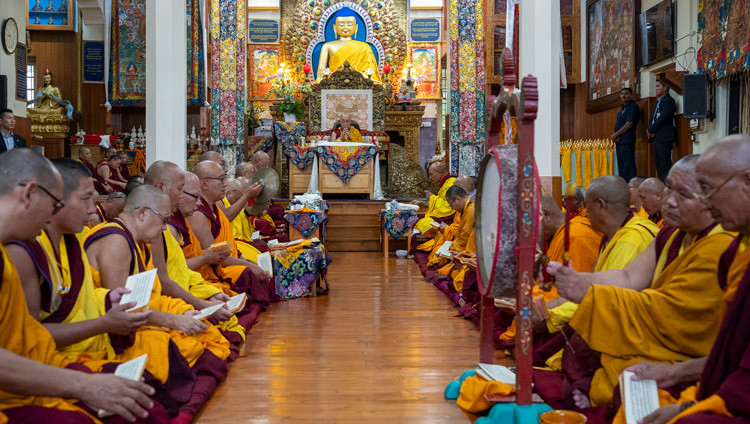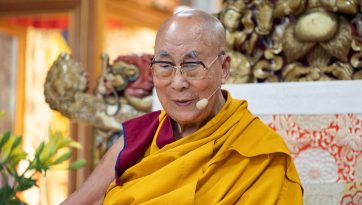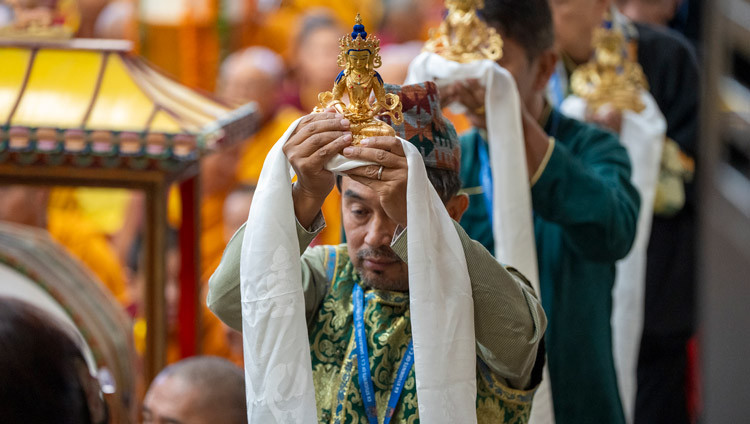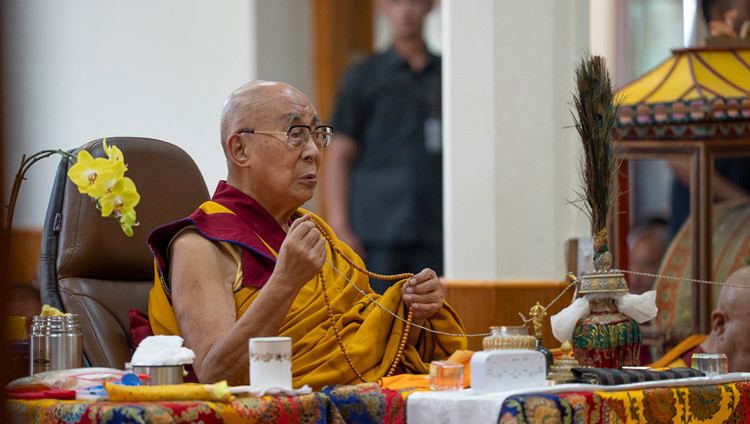The Heart Sutra – Second Day
January 6, 2021
Thekchen Chöling, Dharamsala, HP, India – Ven JinOk opened the second day of His Holiness the Dalai Lama’s teachings with a rhythmic recitation of the ‘Heart Sutra’ in Korean. His Holiness responded, “Today, we’ll continue with our explanation of this text that is recited by most followers of the Sanskrit tradition in Asia.
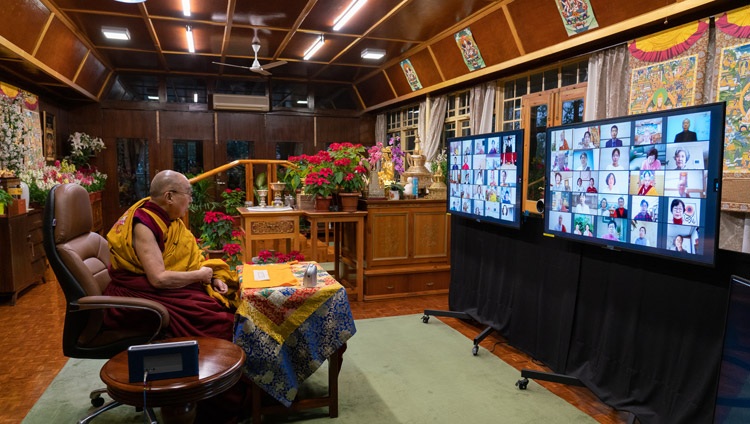
“In the first round of Buddha Shakyamuni’s teachings he made clear that suffering must be known, ignorance must be eliminated and true cessation must be actualized by cultivating the path. The true nature of the mind is clarity and awareness. Mental defilements are temporary and adventitious; therefore, they can be eliminated from the mind. The Nalanda masters taught that the potential to attain enlightenment is naturally within us. The basic nature of the mind can be recognised. As we eliminate defilements, the qualities of a Buddha, such as the ten powers and so forth, naturally emerge.
“In our monastic centres of learning we study the works Nagarjuna and Chandrakirti composed on the basis of reason and logic. Chandrakirti says that the profound view of emptiness can be realized by those with a propensity from the past.
“Mind Only and the Middle Way are the two principal Buddhist schools of philosophy. Mind Only states that there is no duality between subject and object. The Middle Way School asserts that things do not exist independently. The Middle Way Consequentialists represented by Chandrakirti declare that if it is asserted that things have some objective or self-characterized nature then four logical absurdities ensue.
“If things had some sort of existence from their own side, the way ignorance misconceives it, it should be findable. The different forms, sounds and smells around us appear to exist from their own side, but cannot be found to actually exist that way. Even the form body and truth body of a Buddha cannot be found when their intrinsic identity is sought.
“‘Form is empty’, so it can’t be found under analysis. But does this mean it doesn’t exist? It does not, because form exists in dependence on other factors. As I yesterday quoted Nagarjuna as saying, ‘That which is dependently arisen is explained to be emptiness. That, which is a dependent designation is itself the middle way’. Since form and so forth exist and affects us, we say that they exist, but not by their own nature.”
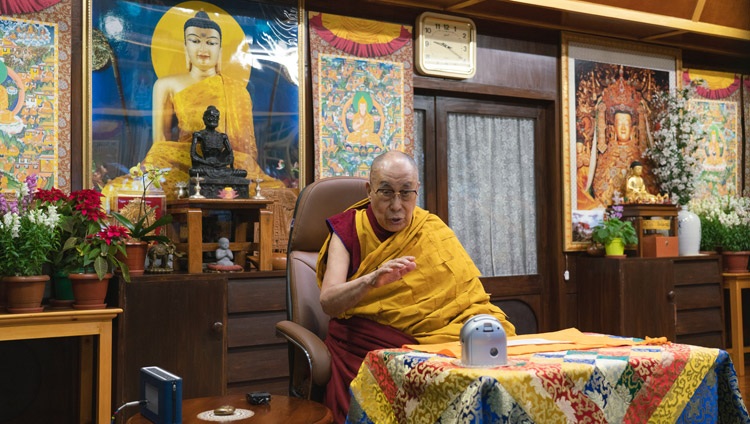
His Holiness read through the text and highlighted the reference to the twelve links of dependent arising, ‘There is no ignorance, no cessation of ignorance and so on up to no old age and death, and no cessation of old age and death’.
He asked, if you understand emptiness will you be able to eliminate the obscurations to knowledge? The answer is ‘No’, because to do this requires an accumulation of merit and wisdom. He then clarified that by giving you accumulate merit. But if you give, motivated by the wish to attain enlightenment for all sentient beings, as long as space endures, such a far-sighted vision will generate immense merit. And that immense merit will help you eliminate obscurations to knowledge.
The awakening mind of bodhichitta, the courageous heart aspiring to achieve Buddhahood for the sake of all sentient beings, is something remarkable. It counters the self-cherishing attitude, as well as undermining the misconception of a self of persons and phenomena. If you have a warm heart, your motivation will be pure. Adverse circumstances will be transformed into favourable conditions.
The awakening mind brings happiness in the short term and in the long run leads to enlightenment. The most profound means for cultivating it is the practice of equalizing and exchanging self and others. The gist of this is to imagine taking the suffering of others upon yourself and giving your happiness to them.
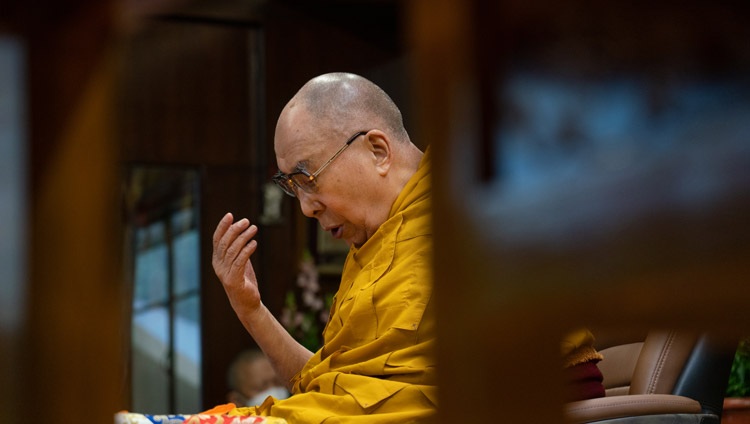
In his ‘Entering into the Way of a Bodhisattva’, Shantideva extols this powerful practice as follows:
For those who fail to exchange their own happiness for the suffering of others, Buddhahood is certainly impossible – how could there even be happiness in cyclic existence? 8/131
His Holiness revealed how progress on the path is indicated by the mantra of the ‘Heart Sutra’. Gaté gaté — proceed, proceed — indicates the path of accumulation, which we reach with our initial experience of bodhichitta, and the path of preparation that is associated with the initial understanding of emptiness. Paragaté — proceed beyond — represents the path of seeing, the first insight into emptiness and achievement of the first bodhisattva ground. Parasamgaté — thoroughly proceed beyond — denotes the path of meditation and the achievement of the subsequent bodhisattva grounds. Bodhi svaha — be founded in enlightenment — signifies laying the foundation of complete enlightenment.
His Holiness reiterated that in order to reach Buddhahood, we need to acquaint ourselves with the awakening mind of bodhichitta and an understanding of emptiness every day. He announced that he will conduct a ceremony for generating the awakening mind tomorrow.
The first questioner today asked whether we may become more attached to ourselves in the course of spiritual practice. His Holiness answered that affection for ourselves occurs naturally and instinctively. He remarked that Buddha Shakyamuni saw he had the potential to reach perfection, so he accumulated merit and wisdom for three countless aeons. Arya Asanga, because of his passion to help others, meditated long on Maitreya of whom he had a vision and from whom he received teachings. His too is a case where attachment to the goal can be seen as synonymous with compassion.
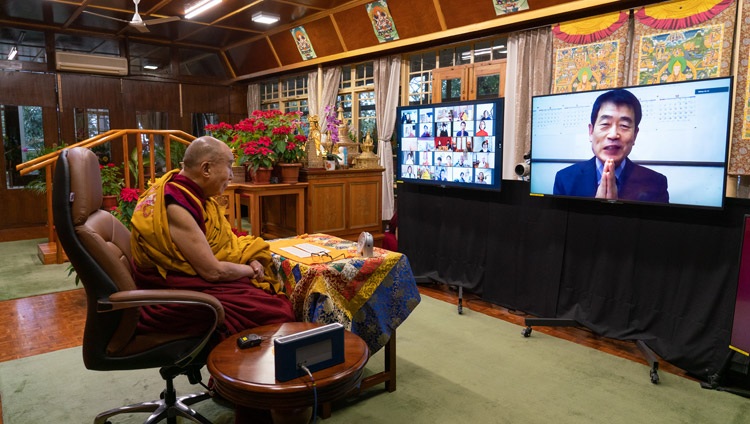
Touching on relations with a spiritual friend, His Holiness quoted Jé Tsongkhapa’s statement in his ‘Great Treatise on the Stages of the Path’, that those who will tame others should first tame themselves. A teacher should be disciplined and should have achieved realization within the context of the three trainings in ethics, concentration and wisdom.
He noted that to repay a teacher’s kindness, especially if you are no longer with them, you need to practise what they taught. Recall their teachings, reflect and meditate on them and so integrate what you’ve been taught within yourself.
Responding to an artist who had asked if there were any works of art that had particularly moved him, His Holiness declared that the works of art that he found most amazing were nuclear weapons — so powerfully destructive. He also mentioned airplanes. He clarified that we can’t say that either art or technology are unnecessary, but their value depends on how they are used. If art and technology are used to destroy others, it’s really unfortunate. If creativity is driven by a negative state of mind, the result is useless.
His Holiness went on to say that what we all want and need is affection. Therefore, it would be good if art inspired people to show each other kindness and affection. Since we all survive because of the kindness of others, it would be excellent if works of art inspired us to be kind and affectionate in return.
Commenting on different ways of approaching meditation, His Holiness suggested that simply withdrawing the mind, without cultivating any reflection, will not help tackle destructive emotions. Since what brings us ruin is our self-cherishing attitude and our misconceiving the intrinsic existence of beings and things, we need to develop a clear understanding of reality and to learn to cultivate concern for others. His Holiness suggested that concentration and mere non-conceptual meditation will not fulfil these goals. He reiterated the importance of cultivating the awakening mind and an understanding of reality.
The session concluded with His Holiness saying, “See you again tomorrow.”

